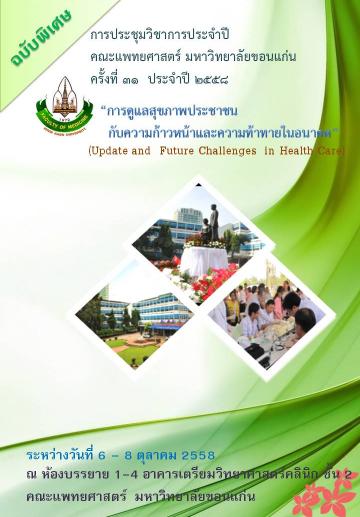Predisposing Factors and Clinical Outcomes of Microbial Keratitis at Srinagarind Hospital
Keywords:
Bacterial keratitis, Corneal ulcer, Fungal keratitis, Microbial keratitisAbstract
Background and Objectives: Microbial keratitis is a common cause of blindness worldwide. Although microbial keratitis can cure with appropriate treatment ,severe microbial keratitis may lead to severe complications. Previous study found that size of lesion more than 6 mm, stromal thinning or perforation and initial visual acuity were related with poor visual outcome . No studies mentioned about patient’s behaviors. Therefore, this study aimed to identify the predisposing factors,microbial profiles, patient’s behaviors after exposing to ocular trauma, treatment outcomes in microbial keratitis patients admitted to Srinagarind hospital.
Methods: This study was initiated by interviewing and recording of new patients with microbial keratitis admitted to Srinagarind hospital prospectively over a 12 month period(April2014-March2015) about demographic data, underlying diseases, predisposing factors such as ocular surface disease, contact lens use, ocular trauma and patient’s behaviors after exposing to ocular trauma, duration of symptom, previous treatment. Visual acuity was assessed, followed by a detailed clinical examination using slit-lamp biomicroscope to evaluate location, size and depth of lesion and edge of lesion, present of hypopyon or stromal thinning or perforation. Intraocular pressure , lens and fundus were assessed if possible. If the patient’s fundus view was obscured , B –scan ultrasonography was performed to rule out endophthalmitis.
Results : The most common predisposing factor was ocular trauma (80.41%). The most common organisms were fungus75% (Pythium insidosum, 25%, Fusarium spp, 25%) followed by bacteria 25% (Pseudomonas spp. 8%, Staphylococcus spp. 8%). Top three of patient’s behaviors after exposing to ocular trauma were rubbing on eye (78.35%), cleaning eye with tap water (27.84%), and earthen jar (16.49%). The vision after treatment was no change 44.33% , worsen 36.08%, improved 19.59%. Poor initial visual acuity and size of lesion 6mm or more were significant predictors for poor visual outcome (P0.01,95% CI 1.71-54.5, P0.01 , 95% CI 1.50-40.12, respectively).
Conclusions: Ocular trauma was a major predisposing factor for microbial keratitis. Most of patients had inappropriate methods to deal with their eyes after injuries . Both bacteria and fungi were common pathogens. Poor initial visual acuity and large size of lesion were related to poor visual outcome.




